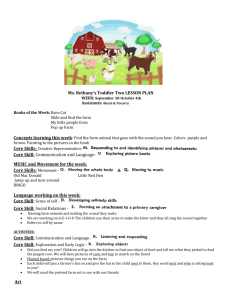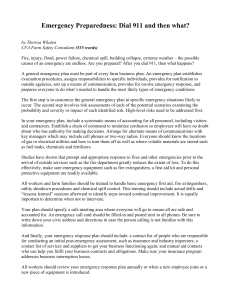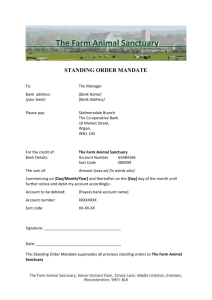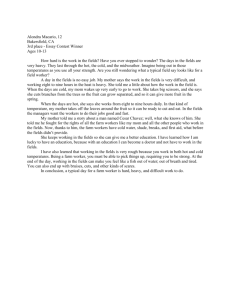Bringing Soul Back to Wai`anae: MA`O Farms
advertisement
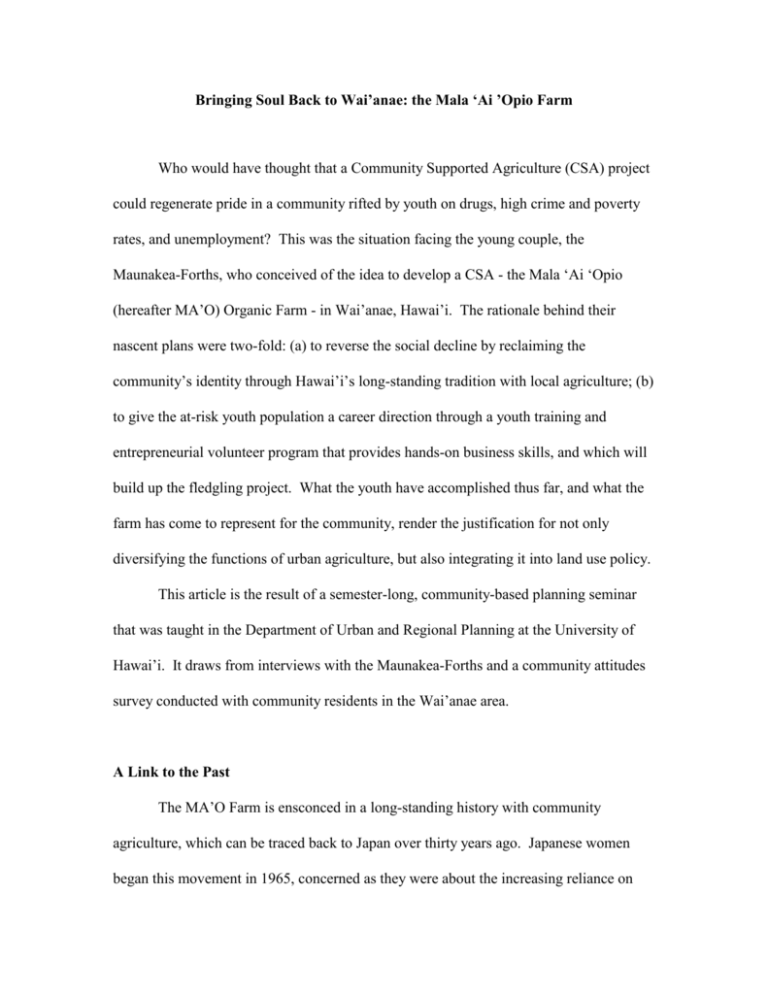
Bringing Soul Back to Wai’anae: the Mala ‘Ai ’Opio Farm Who would have thought that a Community Supported Agriculture (CSA) project could regenerate pride in a community rifted by youth on drugs, high crime and poverty rates, and unemployment? This was the situation facing the young couple, the Maunakea-Forths, who conceived of the idea to develop a CSA - the Mala ‘Ai ‘Opio (hereafter MA’O) Organic Farm - in Wai’anae, Hawai’i. The rationale behind their nascent plans were two-fold: (a) to reverse the social decline by reclaiming the community’s identity through Hawai’i’s long-standing tradition with local agriculture; (b) to give the at-risk youth population a career direction through a youth training and entrepreneurial volunteer program that provides hands-on business skills, and which will build up the fledgling project. What the youth have accomplished thus far, and what the farm has come to represent for the community, render the justification for not only diversifying the functions of urban agriculture, but also integrating it into land use policy. This article is the result of a semester-long, community-based planning seminar that was taught in the Department of Urban and Regional Planning at the University of Hawai’i. It draws from interviews with the Maunakea-Forths and a community attitudes survey conducted with community residents in the Wai’anae area. A Link to the Past The MA’O Farm is ensconced in a long-standing history with community agriculture, which can be traced back to Japan over thirty years ago. Japanese women began this movement in 1965, concerned as they were about the increasing reliance on imported foods and the loss of farm land to urban development. This movement to ‘put the farmers face on food’ was called teikei.1 It eventually spread to Europe and was adapted to North American communities (in 1984) through Robyn Van En, who also organized the first program in North America (in 1986) - the Indian Line Farm in South Egremont, Massachusetts.2 The principles were and are the same as that of the original teikei: (1) farmer-oriented, (2) organic, and (3) biodynamic. The MA’O Farm is the latest addition to what has grown into an international movement. Today, throughout the United States and Canada alone, CSAs number over 1000. Studies of CSAs have augmented with publications that ritually detail their history, suggest guidelines for developing CSAs, the techniques of organic farming, and different funding sources. The CSA has also entered agricultural policy in some states. The United States Department of Agriculture (USDA) in Massachusetts, for instance, allocates a portion of their annual budget to expand operating CSAs. Contributions to the Community What the CSA contributes to the community has been well documented in organic advocacy literature like Community and the Dutch, Ode Magazine. When consumers buy less than 20 percent of their food locally, that means billions of dollars that could be spent on the region is invested elsewhere. Money leaking out of the economy translates to lost revenue, reducing a community’s ability to be self-sufficient. Consumer dollars spent on local farms, in contrast, support not only the economy but the farmer as well, as the revenue can be re-routed in several ways. It can be applied to cover the farm’s production 1 Demuth, 1993. costs, enabling the farmer to continue operating the farm. It can be used as seed money to subsidize the genesis of additional CSAs. The profits have also been known to sustain low-income households, seasonally, with petty cash. Geoff Herbach, in his July 1998 report for the Madison Food System Project, “Harvesting the City: Community Gardening in Greater Madison, Wisconsin”, cites a study published in 1994, which pronounced a savings of $450 for a 600 square foot garden plot. This means money in the bank even for the layman farmer, who practices less-intensive cultivation techniques. Apart from economic benefits, the CSA strengthens community networks and spiritual ties between distant neighbors. As a medium for bringing people together, it serves as the window to the soul, revealing a humanity among us that is triggered when average folks come together to produce something healthy and wholesome for the community. Events sponsored on CSA farms, which celebrate local agriculture, inspire the pride that often arises when identity is attached to “place”, when self is embodied in the land and artifacts bounded in space. And because the burden of operating the farm is shared between the buyers and the farmer, there is an additional feeling of mutuality between farm and community, and a common desire to see an investment succeed. What the CSA also contributes to the community, which park spaces cannot, is an abundance of healthy produce. Cheaper to maintain than park space by thousands of dollars, and more bountiful in terms of rendering something consumable, the CSA feeds the community with non-synthetic, fresh-from-the-ground foods, a gift of health to households. Given all that the CSA can potentially bring into a community, the MA’O Farm seems an antidote to the despair obscuring the town’s true complexion. 2 http://www.csacenter.org Linking up Food Security to Wai’anae Wai’anae’s reputation as a drug and crime infested, impoverished community on the dole echoes throughout the island of Oahu. However, such problems are not immediately apparent as one drives through this bucolic, peaceful, seaside town on the island’s leeward side. The high unemployment rate is implied only by the cube-shaped, one-level plantation houses inland that are reminiscent of Hawai’i’s plantation past. One expects to sight shattered needle vials scattered on the paved streets and boarded up windows of graffiti buildings, common illnesses of inner-city, disenfranchised neighborhoods on the United States continent. Therefore, the tropical serenity of this peri-urban settlement comes as an unexpected surprise. Familiarity, however, begets information. One local daringly confided the insider’s manual on the town’s woes (population: 10,506), to this author on a research visit one Saturday morning. The predominantly Polynesian population can also be found further up north, residing on the beach in makeshift abodes. They are homeless. Teenagers daunted by the costs of higher education, rarely proceed to college, and fail to pick up any real job skills because they don’t see the point. Drugs normally crop up in such circumstances. The local’s narrative is checked against other residents’ testimonies. Confirmed. Verification against the Census 2000 datasets further proves the accuracy of residents’ responses. Although the median family income is $48,145, per capita income is only $13,348, somewhat less than that of the island’s average ($16,256). These figures, juxtaposed against the cost of living - which rose to 80.3% (2000) of wages from 55.1% in 1992 - significantly represent the economic hardship that households face daily. The poverty rate (19.8%) exceeded that of the State (10.4%) and the entire country (12.4%). The unemployment rate (at 8.2%) was equally high, but the percentage of the population that received public assistance (25%) is more compelling; even when employed households must rely on welfare. Wages, alone, are evidently not sufficient for some households to live on. With the median age being 21 in 2000, Wai’anae is clearly a young community. Because youth represent a strong labour force, they are normally considered a regional asset by demographers. Unfortunately, in Wai’anae, this strength is cancelled out by limited educational attainment. The Census 2000 demonstrates that most of the population completed only up to high school (47.4%), compared to a smaller cohort that received an Associates (6.3%) or Bachelors (5.8%) degree. An even smaller percentage continued on to a post-graduate or professional degree (1.7%). An implication of such educational demographics is a paucity of skilled labor that can generate new businesses or other employment incentives for the area, leading to a corollary implication: youth (too often) slide into criminal behavior or engage in drug use, which tends to perpetuate the downward spiral into crime. In Wai’anae, rape, theft, and crystal methamphetamine (street name, “ice”) abuse bring youth into incursions with the law. The MA’O Farm is the bright spot, the silver lining if you will, to the abysmal social conditions in Wai’anae. Residents warmed up to it immediately even before knowing much else apart from a brief description of its mission. In fact, in a community attitudes telephone survey, more than half of those surveyed expressed interest in becoming members. One could also sense that local ownership of the farm influenced respondents’ approval; this is natural as MA’O Farms represents productivity and is contributory. Economically, it provides a food source at less than the market price, allowing even those on welfare to participate. Their entry into the CSA market can be further facilitated if the Farm began accepting food stamps. Judging from the level of interest and at the very least, curiosity, MA’O Farm’s roots in Wai’anae have gradually rejuvenated dignity in the residents and stirred interest in themselves as a community. Food Security and Beyond The MA’O Farm is located a short drive inland from the coast. It is operated on 5-acres of leased land (from a nearby church), with a green house, where seedlings are sprouted before being transplanted to rows. (Source: Honolulu Star Bulletin, March 3, 2004) The vegetables grown are fairly typical of CSAs. There are the usual mesculun greens, varieties of lettuce, bok choy, herbs (especially basil and cilantro), radishes, and green onions. The produce that makes MA’O Farms unique from those located in cooler climates are the tropicals like apple bananas and papayas, as well as the kalo (taro plant), a plant deeply attached to Native Hawaiian culture and has been adopted by contemporary residents. Like many other Indigenous cultures, agriculture is profoundly rooted in the Native Hawaiian identity. Ethnographers have published countless literature carefully expounding on the intricate Native Hawaiian agriculture techniques and elaborate irrigation systems. The legend of Native Hawaiian origins – that they were borne from the taro plant – has become a mythology widely accepted throughout the islands. Later residents, otherwise those who have become rooted in Hawai’i by way of an immigrant past, have also adopted this mystical representation as testament to their own heritage of being from Hawai’i. The MA’O Farms continues to bridge the Native Hawaiian communities with those, which have adopted Hawai’i as their own through restoring the agricultural heritage and incarnating the notion of living off the land. The highlight of the Farm is the youth program. At-risk youth are recruited to spend ten months on the farm learning leadership skills and the mechanics of running an entire business. During this term, they volunteer time working in the fields, planting seeds and weeding in exchange for business skills, namely cash handling, marketing, designing shares, and building the membership base. In the meantime, they also learn about small-scale ecological agriculture, from developing plots to sowing, nurturing the soil, and harvesting. In the spring of 2003, the youth volunteers were involved in a planning session, which aimed to determine box shares, pricing, and other logistics. In one afternoon brainstorming period, much was accomplished. The youth, firstly, all shared ideas on significant details pertaining to the “shares” (boxes per household). They determined the volume of their contents, their constitution, and prices; they clarified whether they should offer half sizes (single for individual) or full (for three or more members of a household). They finally decided on eight core items with supplementary rotating vegetables as they become available seasonally. Secondly, the youth coordinated distribution. Should the shares be delivered door-to-door, organized and serviced by the youth, or should consumers simply pick up at the farm? Can the farm generate enough income to accommodate door-to-door delivery given the added cost of gas and possible car repairs? Moreover, the youth felt it important to inform Wai’anae residents about the nutritional contents of a primarily vegetable diet, as well as the virtues of consuming organics to further engender appeal. Some households, they worried, might not know how to cook the vegetables. Thus, they agreed to include various recipes and designed a brochure that discussed the nutritional benefits of a primarily vegetable diet, which would be included with the shares. As the youth plan for the growth of the MA’O Farm CSA, they are also preparing to manage its future trend. In the process, they learn to collaborate with each other and simultaneously enrich community networks by forging new links between themselves and the community. Potential for Expansion The biggest challenge for the youth volunteers has been to expand the membership base, a prime marketing target because buyers propagate the Farm’s financial sustainability. At the time of research, there were only three steady members, so the youth volunteers have issued fliers and press releases to disseminate word about the Farm’s existence. During 2003, it was promoted in Honolulu’s progressive human interest magazine, the Honolulu Weekly, and was similarly featured in the Honolulu Star Bulletin, a widely circulated newspaper. Otherwise, “coconut wireless” (né “the grapevine”) brings people to MA’O Farm. The volunteers are also searching for venues in which to sell their produce, exploring supermarkets, hospitals, and schools in the area. Presently, the Farm is connected to another equally fortuitous one: the Aloha ‘Aina Café (which means “love the land”), a complementary food business also conceived, managed, and run by the Maunakea-Forths. (Source: Honolulu Star Bulletin, March 3, 2004) It can be found along Farrington Highway, the main artery connecting Wai’anae to Honolulu, where most of the island’s population lives. Here, the Farm’s produce are transformed into sumptuous meals influenced by Wai’anae’s multicultural tapestry. Daily, people from around the island congregate to sample the recipes and, twice a week, to shop at the Farmer’s Market held especially for the Farm in the Café’s parking lot. On the day of the research visit, the Farm already boasted rows and rows of readyto-be-picked produce. The bright red, oval-shaped radishes were bursting from the soil, the basil thickets to maximum density. The youth volunteers’ earnestness is yet revealed in the new linkages they have developed with other institutions around the island, namely the Center for Organic Sustainable Agriculture in the College of Tropical Agriculture and Human Resources (CTAHR) at the University of Hawai’i in Manoa Valley (Honolulu). With faculty support, they can improve upon their organic farming techniques to ensure healthy plantings, yearly. Clearly, the youth are paving the way towards a successful business, and hopefully their experience with the MA’O Farm will be the springboard for future entrepreneurial ventures in Wai’anae. _______________________________________________________________________ Author’s biography: Camille Tuason Mata received her Master of Urban and Regional Planning degree from the University of Hawai’i at Manoa. She is a volunteer for the non-profit organization, Partnership for Human Rights and Development (PaHRD) based in Valencia City, Mindanao, Philippines. References: Robyn van En Center for Community Supported Agriculture Website. <www.csacenter.org> Demuth, Suzanne (1993). “Defining Community Supported Agriculture”. In Community Supported Agriculture (CSA): An Annotated Bibliography and Resource Guide. Alternative Farming Systems Information Center, National Agriculture Library, United States Department of Agriculture. <www.nal.usda.gov/afsic/csa/csadef.html> United States Census (2002) <www.census.gov>

